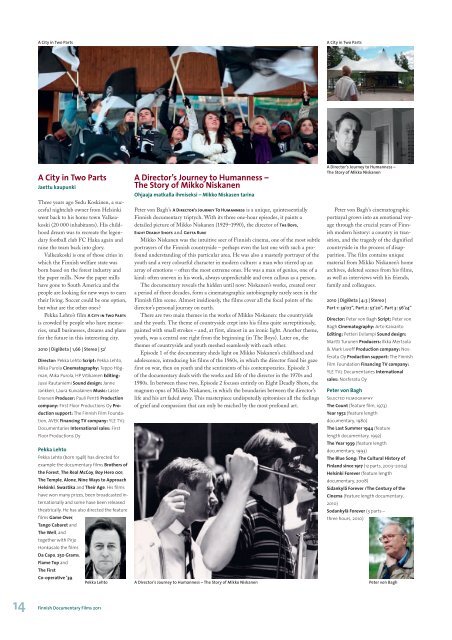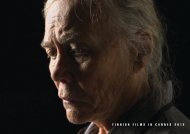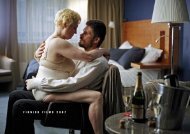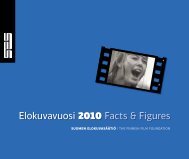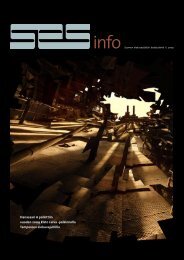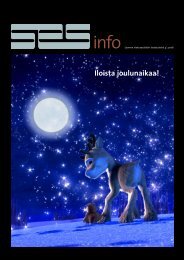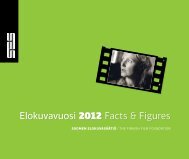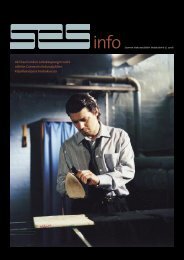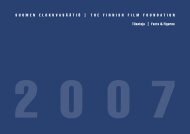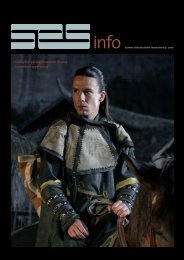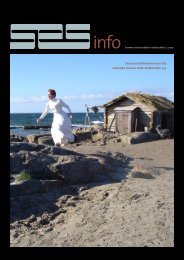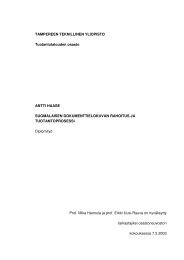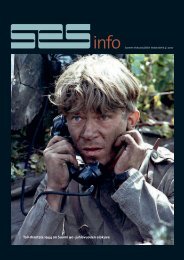Finnish Documentary Films 2011
Finnish Documentary Films 2011
Finnish Documentary Films 2011
You also want an ePaper? Increase the reach of your titles
YUMPU automatically turns print PDFs into web optimized ePapers that Google loves.
A City in Two Parts<br />
A City in Two Parts<br />
A City in Two Parts<br />
Jaettu kaupunki<br />
Three years ago Sedu Koskinen, a succesful<br />
nightclub owner from Helsinki<br />
went back to his home town Valkeakoski<br />
(20 000 inhabitants). His childhood<br />
dream was to recreate the legendary<br />
football club FC Haka again and<br />
raise the team back into glory.<br />
Valkeakoski is one of those cities in<br />
which the <strong>Finnish</strong> welfare state was<br />
born based on the forest industry and<br />
the paper mills. Now the paper mills<br />
have gone to South America and the<br />
people are looking for new ways to earn<br />
their living. Soccer could be one option,<br />
but what are the other ones?<br />
Pekka Lehto’s film A City in Two Parts<br />
is crowded by people who have memories,<br />
small businesses, dreams and plans<br />
for the future in this interesting city.<br />
2010 | DigiBeta | 1,66 | Stereo | 52’<br />
Director: Pekka Lehto Script: Pekka Lehto,<br />
Mika Purola Cinematography: Teppo Högman,<br />
Mika Purola, HP Vitikainen Editing:<br />
Jussi Rautaniemi Sound design: Janne<br />
Jankkeri, Laura Kuivalainen Music: Lasse<br />
Enersen Producer: Pauli Pentti Production<br />
company: First Floor Productions Oy Production<br />
support: The <strong>Finnish</strong> Film Foundation,<br />
AVEK Financing TV company: YLE TV2<br />
Documentaries International sales: First<br />
Floor Productions Oy<br />
Pekka Lehto<br />
Pekka Lehto (born 1948) has directed for<br />
example the documentary films Brothers of<br />
the Forest, The Real McCoy, Boy Hero 001,<br />
The Temple, Alone, Nine Ways to Approach<br />
Helsinki, Swastika and Their Age. His films<br />
have won many prizes, been broadcasted internationally<br />
and some have been released<br />
theatrically. He has also directed the feature<br />
films Game Over,<br />
Tango Cabaret and<br />
The Well, and<br />
together with Pirjo<br />
Honkasalo the films<br />
Da Capo, 250 Grams,<br />
Flame Top and<br />
The First<br />
Co-operative ’39.<br />
Pekka Lehto<br />
A Director’s Journey to Humanness –<br />
The Story of Mikko Niskanen<br />
Ohjaaja matkalla ihmiseksi – Mikko Niskasen tarina<br />
Peter von Bagh’s A Director’s Journey To Humanness is a unique, quintessentially<br />
<strong>Finnish</strong> documentary triptych. With its three one-hour episodes, it paints a<br />
detailed picture of Mikko Niskanen (1929–1990), the director of The Boys,<br />
Eight Deadly Shots and Gotta Run!<br />
Mikko Niskanen was the intuitive seer of <strong>Finnish</strong> cinema, one of the most subtle<br />
portrayers of the <strong>Finnish</strong> countryside – perhaps even the last one with such a profound<br />
understanding of this particular area. He was also a masterly portrayer of the<br />
youth and a very colourful character in modern culture: a man who stirred up an<br />
array of emotions – often the most extreme ones. He was a man of genius, one of a<br />
kind: often uneven in his work, always unpredictable and even callous as a person.<br />
The documentary reveals the hidden until now: Niskanen’s works, created over<br />
a period of three decades, form a cinematographic autobiography rarely seen in the<br />
<strong>Finnish</strong> film scene. Almost insidiously, the films cover all the focal points of the<br />
director’s personal journey on earth.<br />
There are two main themes in the works of Mikko Niskanen: the countryside<br />
and the youth. The theme of countryside crept into his films quite surreptitiously,<br />
painted with small strokes – and, at first, almost in an ironic light. Another theme,<br />
youth, was a central one right from the beginning (in The Boys). Later on, the<br />
themes of countryside and youth meshed seamlessly with each other.<br />
Episode 1 of the documentary sheds light on Mikko Niskanen’s childhood and<br />
adolescence, introducing his films of the 1960s, in which the director fixed his gaze<br />
first on war, then on youth and the sentiments of his contemporaries. Episode 3<br />
of the documentary deals with the works and life of the director in the 1970s and<br />
1980s. In between those two, Episode 2 focuses entirely on Eight Deadly Shots, the<br />
magnum opus of Mikko Niskanen, in which the boundaries between the director’s<br />
life and his art faded away. This masterpiece undisputedly epitomises all the feelings<br />
of grief and compassion that can only be reached by the most profound art.<br />
A Director’s Journey to Humanness – The Story of Mikko Niskanen<br />
A Director’s Journey to Humanness –<br />
The Story of Mikko Niskanen<br />
Peter von Bagh’s cinematographic<br />
portrayal grows into an emotional voyage<br />
through the crucial years of <strong>Finnish</strong><br />
modern history: a country in transition,<br />
and the tragedy of the dignified<br />
countryside in the process of disapparition.<br />
The film contains unique<br />
material from Mikko Nis kanen’s home<br />
archives, deleted scenes from his films,<br />
as well as interviews with his friends,<br />
family and colleagues.<br />
2010 | DigiBeta | 4:3 | Stereo |<br />
Part 1: 59’07”, Part 2: 57’20”, Part 3: 56’24”<br />
Director: Peter von Bagh Script: Peter von<br />
Bagh Cinematography: Arto Kaivanto<br />
Editing: Petteri Evilampi Sound design:<br />
Martti Turunen Producers: Ilkka Mertsola<br />
& Mark Lwoff Production company: Nosferatu<br />
Oy Production support: The <strong>Finnish</strong><br />
Film Foundation Financing TV company:<br />
YLE TV2 Documentaries International<br />
sales: Nosferatu Oy<br />
Peter von Bagh<br />
Selected filmography<br />
The Count (feature film, 1973)<br />
Year 1952 (feature length<br />
documentary, 1980)<br />
The Last Summer 1944 (feature<br />
length documentary, 1992)<br />
The Year 1939 (feature length<br />
documentary, 1993)<br />
The Blue Song: The Cultural History of<br />
Finland since 1917 (12 parts, 2003–2004)<br />
Helsinki Forever (feature length<br />
documentary, 2008)<br />
Sidankylä Forever /The Century of the<br />
Cinema (feature length documentary,<br />
2010)<br />
Sodankylä Forever (3 parts –<br />
three hours, 2010)<br />
Peter von Bagh<br />
14 <strong>Finnish</strong> <strong>Documentary</strong> <strong>Films</strong> <strong>2011</strong>


